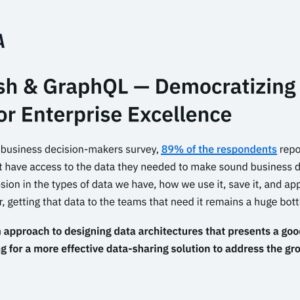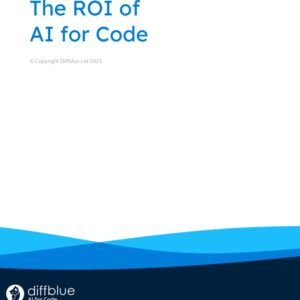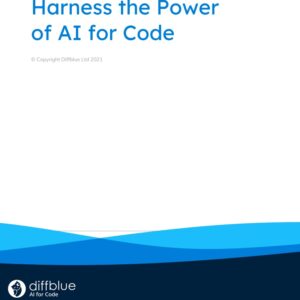To serve their users more efficiently, improve security, and enhance processes and productivity, the Legislative Applications department of the U.S. House of Representatives set out to modernize its 30-year-old technology stack.
As an integral part of the government operating in a regulated field, they had to ensure their new tech stack was secure, resilient, and future-proof.
Some of the goals for this modernization project were to:
Find out why a branch of Congress chose Hasura, and the benefits they’ve attributed to using them.

As with most 2022 trends in the development world, discussions around integration focus on the same topic: speed.
What are the common integration patterns and anti-patterns, and how do they help or hurt overall operational efficiency?
Download this resource to see the survey results and read the report!
There has been an explosion in the types of data we have, how we use it, save it, and apply it to different contexts. However, getting that data to the teams that need it remains a huge bottleneck.
Learn how taking a data mesh approach to designing data architectures is a more effective data-sharing solution to address the growing number of data use-cases.
Download this whitepaper to learn more about this approach.

Are you looking to get started on your Value Stream Management (VSM) implementation? Or maybe you’re looking to enhance your current VSM journey. Do you want to get started right away and start realizing more value for your customers?
This e-book guides you through: A closer look at your DevOps pipeline, comparing value stream mapping and management, the importance of (VSM), and a look at the benefits.
VSM is about accelerating development and enabling continuous delivery. We all know incorporating value stream mapping to identify the different activities in your pipeline – and where bottlenecks and waste reside – is extremely important. We think that requires the enhancement of four key areas.
Successful organizations have followed them. What are they and how do they help? Download this e-book to find out!

What’s shaping modern application development, and how is it changing in 2022?
This webinar unveils the top five roadblocks causing disruption in application development and key standout accelerating trends that will help create more streamlined alignments within the functional organization.
Armory CEO Jim Douglas and market analyst firm EMA Vice President of Research, Dennis Drogseth discuss what they’ve learned based on EMA’s recent analysis, “The State of Modern Application Development: A Journey from Speed to Awareness”, and dive into increasing trends such as:
Watch the discussion today and see how your organization compares in terms of its modern application development and how these survey trends can make your business and teams more successful.

Unit testing is important for code quality, but if you’ve never done it before how would you know where to begin? And even if you’re an experienced developer, are there ways you could unit test more effectively.
This guide provides a start-to-finish overview of unit testing in Java. Among the topics covered are:
Download this guide today for insight into how to optimize delivery of your Java applications!

AI for Code makes it possible to automate the creation of repetitive, basic code, leaving engineers free to focus on the high-level creative problem solving that advances the business.
But the potential of innovative new technology can be tough to express in terms of financial outcomes, leading business leaders to ask, “How do you prove the value of this technology?” and “How do I calculate its ROI?”
This ebook shows the value of employing AI for Code in your Java applications.
Download it now to learn how automation can lead to higher engineering productivity and lower technical debt.

More of the world’s businesses and public services depend on well-written code than ever before. However, with rapid innovation and the constant evolving roles of employees and contractors, knowledge of the code in an organization fades quickly, and code that is sometimes only a few years old becomes complex to maintain.
Global companies are investing billions of dollars into digital programs that become full of legacy code in a handful of years, and with the move to cloud and microservices, the need to understand and transform monoliths and legacy code has become an imperative.
This e-book covers five alternative options for tackling the challenga of legacy Java applications. Download it today to find out what they are!

There’s a lot of buzz around Artificial intelligence (AI) and its potential to revolutionize everything from retail to transportation to healthcare. But what exactly is ‘AI for Code?’
This white paper provides a few practical examples of how artificial intelligence (when harnessed properly) can provide scalable business-critical benefits. It guides you through the next steps for integrating this powerful technology into your development processes, and how to leverage it to outpace your competitors.
We specifically cover:
Download the whitepaper today!

Implementing DevSecOps positively is critical for any organization that needs to deploy apps and programs quickly and securely.
One proven method to achieve this is through security champions at both the executive and development levels. The AppSec-side champion works hand-in-hand with the CISO and other executives to generate support and execute security programs at the organizational level, while the second method is a hands-on, engineering-based champion working directly with their fellow developers and takes on more of a coaching role. The most innovative and successful organizations employ both.
This whitepaper will provide insights into these roles, the benefits they bring, and what to look for in your next set of security coaches and champions.

Ensuring the security of an application these days is just as important as the core function of the application itself. While you are still rolling out patches for a previous bug, your code is vulnerable and out in the wild.
And the threat landscape continues to evolve at an alarming rate. This means that coding an application that is functional, but which exposes your business to a potential exploit, is just as much a failure as developing a product or application that doesn’t perform properly.
Get the guide to learn more!

The focus on automation, tooling and reactive responses to cyber threats can no longer stand alone against an increasingly sophisticated threat landscape, where attackers are also employing advanced tools to successfully breach even the most protected networks and systems. What is needed is a developer-driven approach to software security, with security-skilled developers who are incentivized and regularly trained to become a vital part of an organization’s cybersecurity defenses.
Only a balanced defense using tools, automation and highly trained people can provide a pathway for long-term success in today’s increasingly threat-laden digital environment.
Explore this new whitepaper to learn more about:

